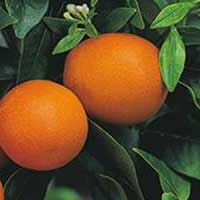 Full List of Fruits
Full List of Fruits  Spiny Monkey-orange
Spiny Monkey-orangeSpiny Monkey-orange
![]() Introduction of Spiny Monkey-orange
Introduction of Spiny Monkey-orange
Scientific name - Strychnos spinosa
The Spiny monkey trees grow in the tropical and sub tropical climatic conditions in the places of Africa. They are found to have a normal size sometimes smaller too. They come under the deciduous category of trees having many spines in them, at the time of fall their leaves become yellow in color, the top most branches of the tree are found to be flat, irregular and the branches are very crowded, the flowers which are produced have a green to white color which are found in large numbers mainly at the branch’s end in the months of September to February which is the season between spring to summer, the fruits are borne only when a good amount of rainfall is obtained. The fruits are found to be juicy, having sweet to sour flavors, yellow in their color, with a large number of seeds which are brown in color. The fruits are hardy and found to have a smooth texture and are big in size having a green color which turns out to be yellow after ripening, the fruits have firmly placed seeds covered by pulpy, consumable flesh.
![]() Nutritional Value of Spiny Monkey-orange
Nutritional Value of Spiny Monkey-orange
| Ca | 56 |
| Mg | 49 |
| K | 1370 |
| Na | 21.7 |
| Fe | 0.11 |
| Zn | 0.22 |
The plant is domesticated as a food plant in the countries of Africa historically, the sparsely recognized fruit has the ability to enhance the nutrition, increase the food security, helps in rural development aids in the continuous land maintenance, the trees wood helps in normal carpentry, the wood is also helpful in manufacture of fighting sticks and also hut poles, they also aid in carving, This plant is newly introduced in Israel and is doing well as a commercial crop there. The fruit is also used as a substitute of food in the villages when there no food sometimes.
![]() Health Benefits of Spiny Monkey orange
Health Benefits of Spiny Monkey orange
The plants various parts such as the leaves, roots, fruits and also their seeds have many medicinal values , the root’s infusions helps in treating snakebites, also the trees bark and the fruits which are unripe is used for treating snakebites, the contents of strychnine present in barks of the trees added with many alkaloids and unripe fruit helps in eradicating the venom in some snakes like Mamba. This Strychnine contents are used to stimulate the central nervous system thus combating the respiratory depressions produced through the snakes venom. They are used for laxative purposes, solves the uterine complications and also in the treatment of sore eyes. The decoction prepared from the leaf and also the root aids as an analgesic in the regions of Central Africa, grinded form of the roots and also its extract helps in solving the inner part of the body’s complications like the stomach and also the bowels to combat problems such as diarrhea and also the worms too.
![]() Culture of Spiny Monkey orange
Culture of Spiny Monkey orange
The fruits seem to look visually pleasing containing shiny leaves which are dark green in their color and yield dark yellow colored fruits, they fall under the deciduous category of trees but during fall the color turns out to be yellow seems to be pleasing, they are used as a fencing material and also as a border, they are hard in nature and withstands soils which are poor and rocky in nature.
The plant thrives in the dry, tropical and also subtropical savannahs, they can grow in ranges of height approximately 1,500 meters and even more too. They grow in places where there is temperatures ranging from 20-28 degrees only in the day time and has the capacity to withstand 15-32 degrees and sometimes can tolerate light frosts too. The rainfall needed is 700-1000mm and also can bear 600-1500mm, they only prefer full sunlight but sometimes withstand shades too, the soils must be well-drained and also adaptable in rocky places too, and the pH level needed is 5-7 and also can withstand 4.5-7.5, the plant crops out quicker from the seeds and gives a good yield too. Different forms of cultivation resulted in the production of various shapes of fruits some seedless too.
The seeds must be kept in the hot water and sometimes the coating which is very firm is burnt to help the germination process, they have root suckers and these roots must be pruned in order to develop suckering , half-ripened woods cuttings also are used.


















